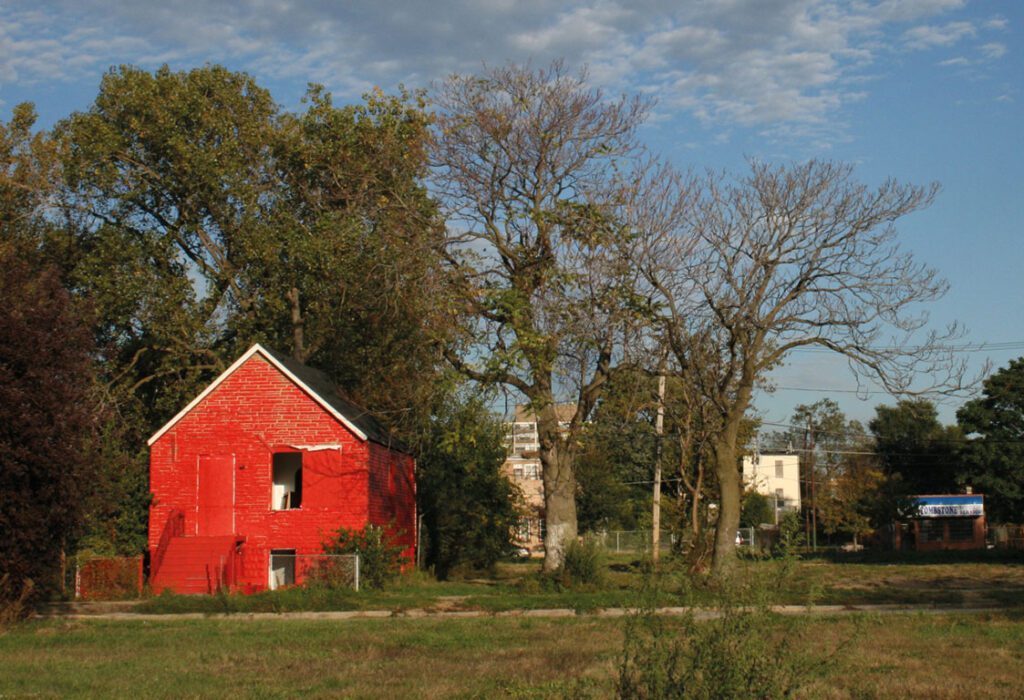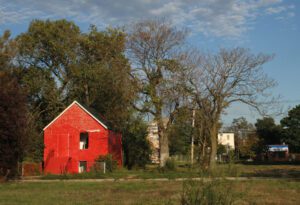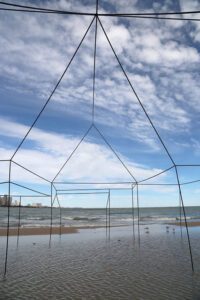
Color(ed) Theory,” the last house in a series of eight by Amanda Williams
A TALE—AND THOUGHTS–OF TWO HOUSES
“

A wall pitted by a single air rifle shot.” That was the sentence the Museum of Modern Art received from artist Lawrence Weiner. The interpretation was up to them. They could write it as is, fake the scene it described, or, most straightforward, just shoot the wall.
Encountering the works of Sarah FitzSimons and Amanda Williams, two artists featured in the 2015 Chicago Architecture Biennial, is like witnessing two people who have read the same Weiner sentence turn around to construct the distinct worlds each envisioned. Given the same prompt, obvious connections would arise. But the revelations would be in the divergence of details.
On Oak Street Beach, where sand and water meet, there’s a two-story house, entirely empty. That’s FitzSimons’s “House.” It’s a typical Midwestern home, if typical means having sand for floors, air for walls, and a roof of open sky. In terms of physical material, “House” consists only of aluminum poles and joints that outline a three-dimensional structure. Not all that useful for living, but great for dreaming.
It’s a good place to dream. On a sunny weekend day, wedding parties aren’t an unusual sight, strolling through nearby Milton Lee Olive Park on their way to take pictures. They smile in front of the Chicago skyline with Lake Michigan, an endless stretch of blue, in the background.
In this context, “House” becomes a vessel to fill with plans, hopes and grand ideas. After all, this city on a lake began with people who dreamed of building something new as well.
About nine miles to the south, where South Lafayette meets West 57th Street in Washington Park, there’s another house. It’s two stories, with a small front porch and four clapboard walls. In a city of nearly three million residents, it somehow stands isolated from the buildings around it. Like “House,” it’s entirely empty. It’s also Flamin’ Hot Cheetos Red.
This is part of “Color(ed) Theory,” the last house in a series of eight that artist Amanda Williams painted in colors that reflect the black urban experience on Chicago’s South side, colors like Pink Oil Moisturizer Pink and Currency Exchange Yellow. Collectively, the colors form a cultural code, markers of poverty immediately recognizable only to those who’ve lived or seen it.
As in “House,” they’re reduced to their outer frames, what remains when you paint something all one color. But these aren’t places to fantasize about. Vacant and slated for demolition, their emptiness begs questions: Who lived here? What did they mean to this community? What stories are going untold? Williams uses color to stimulate a conversation about what color denotes poverty and which speaks of gentrification.
Though only tenuously connected by the Biennial, “House” and “Color(ed) Theory” feel, in many ways, like they’re in dialogue with each other across the city of Chicago. It’s a conversation about the fact that, between 2000 and 2010, downtown saw 79% population growth, while Washington Park lost 17% of its residents.

They call attention to how an empty building on a beach at Oak Street signifies someone moving in, or something bigger being built while, in the latter location, it will probably be left to fall apart, torn down, or become the next candidate for redevelopment. They question who gets to decide what has value and what that value even means.
In this conversation, the more compelling voice emerges. Williams has hit on a critical cultural moment, when the Black Lives Matter movement is reminding us, yet again, how little this country values its citizens of color. Her houses’ vibrant palette shouts to a nation that is violently trying to maintain silence. They refuse to fade from view.
This might make some people uncomfortable. I’d say that’s a good thing. It’s also where “Color(ed) Theory” and “House” diverge most. “House” has initial appeal but lacks the power of necessity as “Color(ed) Theory” does. It’s art, far from a center of wealth, for the people who are living there now. It forces those of privilege to reckon with how they can build their American Dreams while, for others, that promise started out broken. Williams’ houses are provocative, grounded and art we need more of.
Williams fired Weiner’s bullet, so to speak, into the wall. I hope the shot rings long after the Biennial ends.
Alex Cornacchia
BA graduate of Vassar College in psychology and art history, Alex Cornacchia lives and writes in Chicago, her newly-adopted city.
Volume 30 number 2, November / December 2015 pp 11-12

